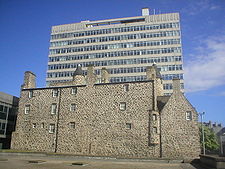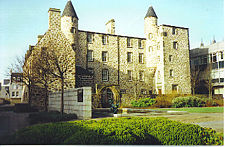
Provost Skene
Encyclopedia


Aberdeen
Aberdeen is Scotland's third most populous city, one of Scotland's 32 local government council areas and the United Kingdom's 25th most populous city, with an official population estimate of ....
, Scotland
Scotland
Scotland is a country that is part of the United Kingdom. Occupying the northern third of the island of Great Britain, it shares a border with England to the south and is bounded by the North Sea to the east, the Atlantic Ocean to the north and west, and the North Channel and Irish Sea to the...
in the 17th century from (1676-1685). Today he is most famous and widely known not for his time as Lord Provost, but for his house which is a major tourist attraction in Aberdeen.
Provost Skene's house
Dating from 1545, Provost Skene's House was bought in 1669 by Provost Skene.It was opened to the public in 1953 as a 'Period House and Museum of Local History' by Her Majesty, Queen Elizabeth the Queen Mother. The rooms have been furnished in the styles of the 17th, 18th and early 19th centuries. There are collections of coins and local history, while the Painted Gallery contains a series of religious paintings. The Costume Gallery presents regularly changing displays of period dress.
The house is much altered, but is a rare survival of Aberdeen's medieval burgh
Burgh
A burgh was an autonomous corporate entity in Scotland and Northern England, usually a town. This type of administrative division existed from the 12th century, when King David I created the first royal burghs. Burgh status was broadly analogous to borough status, found in the rest of the United...
architecture. It is thought that George Skene commissioned the carved plaster ceilings in the 17th century. In an attic gallery a Renaissance painted ceiling
Scottish Renaissance painted ceilings
A number of Scottish houses and castles built between 1540 and 1640 have painted ceilings. This is a distinctive national style, though there is common ground with similar work elsewhere, especially in France, Spain and Scandinavia. Most surviving examples are painted simply on the boards and...
, including strapwork decoration and religious scenes, was commissioned by a member of the Lumsden family.
Rated a three star museum by the Scottish Tourist Board, the museum is free to the public.
External links
- Provost Skene's House - official site at Aberdeen Art Gallery & Museums
- Pictures and history of the house.
- History of the house.
- Aberdeen City Council website.
- 24 Hour Museum article.

